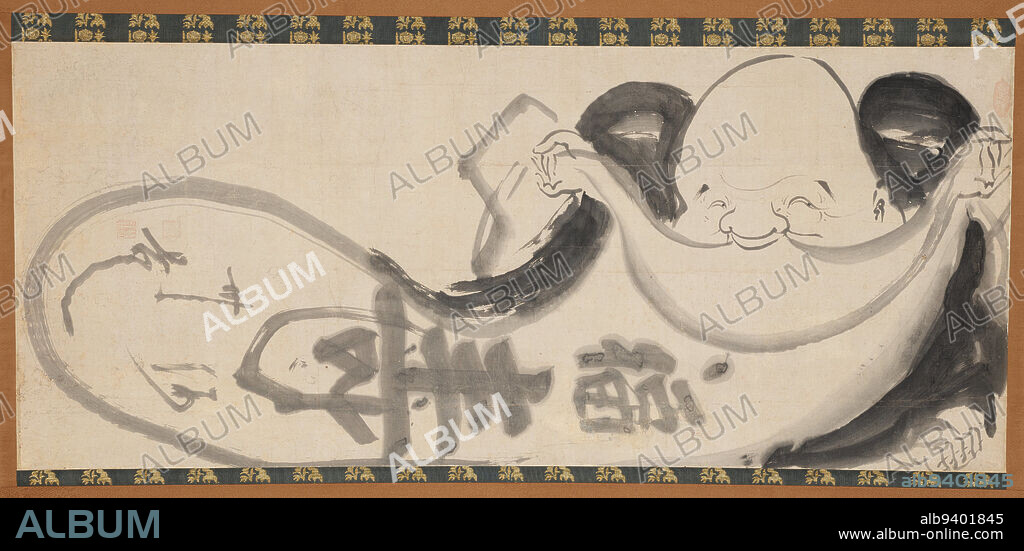alb9401845
Budai Opening His Sack, mid 18th century, Hakuin Ekaku, Japanese, 1685 - 1769, 21 3/4 × 50 15/16 in. (55.25 × 129.38 cm) (image)59 × 53 1/2 in. (149.86 × 135.89 cm) (without roller), Ink on paper, Japan, 18th century, Hakuin Ekaku (16851769), a Zen priest and prolific amateur painter, is credited with reviving the Rinzai sect of Japanese Zen Buddhism after a long period of decline. Hakuin focused on meditation and paradoxical anecdotes or dialogues called kan, the contemplation of which may lead to spontaneous awakening. Hakuins bold, sometimes humorous, and altogether unprecedented paintings were an important vehicle for his teachings, which spread far beyond the monasteries and captured the minds of laypeople. This painting represents one of Hakuins unique and humorous takes on the popular Buddhist figure called Budai, an eccentric wandering monk who is nearly always shown carrying a large cloth sack that holds all of his belongings. Here, he holds the big cloth sack open for us, begging us to peer inside. An inscription, brushed sideways on the sack, reads, 'Life and happiness are as endless as the sea.

|
Add to another lightbox |
|
Add to another lightbox |



Buy this image.
Select the use:

Caption:
Budai Opening His Sack, mid 18th century, Hakuin Ekaku, Japanese, 1685 - 1769, 21 3/4 × 50 15/16 in. (55.25 × 129.38 cm) (image)59 × 53 1/2 in. (149.86 × 135.89 cm) (without roller), Ink on paper, Japan, 18th century, Hakuin Ekaku (16851769), a Zen priest and prolific amateur painter, is credited with reviving the Rinzai sect of Japanese Zen Buddhism after a long period of decline. Hakuin focused on meditation and paradoxical anecdotes or dialogues called kan, the contemplation of which may lead to spontaneous awakening. Hakuins bold, sometimes humorous, and altogether unprecedented paintings were an important vehicle for his teachings, which spread far beyond the monasteries and captured the minds of laypeople. This painting represents one of Hakuins unique and humorous takes on the popular Buddhist figure called Budai, an eccentric wandering monk who is nearly always shown carrying a large cloth sack that holds all of his belongings. Here, he holds the big cloth sack open for us, begging us to peer inside. An inscription, brushed sideways on the sack, reads, 'Life and happiness are as endless as the sea.
Personalities:
Credit:
Album / quintlox
Releases:
Image size:
8400 x 4083 px | 98.1 MB
Print size:
71.1 x 34.6 cm | 28.0 x 13.6 in (300 dpi)
Keywords:
(JAPAN) • 1685-1769 • 16851769 • 18TH CENTURY • 18TH CENTURY, THE • 18TH CENTURY. • 18TH • ABBEY • ALTOGETHER UNPRECEDENTED PAINTINGS • BARREL • BEGGING US • BELONGINGS • BIG CLOTH SACK OPEN • BRUSHED SIDEWAYS • BUDAI OPENING • BUDAI • CAPTURED • CHEERFULNESS • CLOISTER • CONTEMPLATION • CONVENT • CREDITED • CURLER • CYLINDER (BARREL) • DECLINE • DIALOGUES • DRUM • ECCENTRIC WANDERING MONK • ENDLESS • FLEET • GAIETY • GOOD FORTUNE • GOODS AND CHATTELS • HAKUIN EKAKU • HAKUIN FOCUSED • HAKUIN'S BOLD • HAKUIN'S UNIQUE • HAPPINESS • HILARITY • HOLDS • HUMOROUS TAKES • IMAGE • IMPORTANT VEHICLE • INK ON PAPER • INSCRIPTION • JAPAN • JAPAN. • JAPANESE ZEN BUDDHISM • JAPANESE • JOY • K • LARGE CLOTH SACK • LAYPEOPLE • LEAD • LIFE • LIVELINESS • LONG PERIOD • MARINE • MEDITATION • MERRIMENT • MID 18TH CENTURY • MINDS • MONASTERIES • MONASTERY • NAVY • NEARLY • OCEAN • OCEANS • PAINTING REPRESENTS • PARADOXICAL ANECDOTES • PEER INSIDE • POPULAR BUDDHIST FIGURE • PROLIFIC AMATEUR PAINTER • READS • REVIVING • RINZAI SECT • ROLLER • SACK • SEA • SEA. • SEAS • SHOWN CARRYING • SOMETIMES HUMOROUS • SPONTANEOUS AWAKENING • SPREAD FAR BEYOND • TEACHINGS • US • WILDNESS • XVIII CENTURY • ZEN PRIEST


 Pinterest
Pinterest Twitter
Twitter Facebook
Facebook Copy link
Copy link Email
Email
